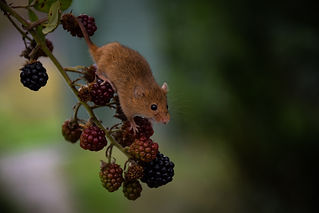
MICE & OTHER
RODENTS
Mice are a common pest that can infest honeybee hives, particularly during the winter months when the bees are clustered together and there is less activity in the hive.
Honeybees face many threats in their hives, including pests and predators that can cause damage to their colonies. One such pest is the common house mouse (Mus musculus), which can cause significant damage to bee hives if left unchecked.
Symptoms: Mice can cause a number of problems for honeybee colonies. They are attracted to the warmth and food sources found in the hive, and will often chew through honeycomb and wax to access these resources. This can cause damage to the hive's structure and lead to the loss of honey and pollen stores. Mice also carry diseases that can be harmful to honeybees, including salmonella and E. coli. These diseases can spread quickly throughout the colony and have a devastating impact on the bees' health.
Treatments: There are a few different methods for controlling mouse infestations in honeybee colonies. One effective approach is to use mouse guards on the hive entrance, which can prevent mice from entering in the first place. These guards can be made from a variety of materials, such as metal mesh or foam, and should be regularly inspected for any signs of damage or wear.
Another option is to use mouse traps or bait stations placed around the hive. These should be positioned carefully to avoid attracting other pests or predators, and should be checked and reset regularly to ensure they remain effective.
Prevention Measures: Preventing mouse infestations is often easier than treating them once they have taken hold. Regular inspections of the hive and surrounding area can help to identify potential entry points for mice, such as cracks or gaps in the hive structure. These should be repaired promptly to prevent mice from gaining access.
Keeping the area around the hive clean and free from food debris can also help to discourage mice from taking up residence nearby. Regular removal of any fallen or excess honeycomb can help to reduce the food sources available to mice and other pests.
Cures: There are currently no cures for diseases that may be introduced by mice in honeybee colonies. Prevention measures, such as those outlined above, are the best defence against the harmful effects of mouse infestations.
In severe cases, it may be necessary to remove and replace any contaminated combs or frames from the hive. This can help to prevent the spread of disease and restore the health of the colony.
Mice can be a serious threat to honeybee colonies, causing damage to the hive's structure and introducing harmful diseases. Effective prevention measures, regular inspections, and prompt treatment of infestations are key to maintaining healthy hives and protecting honeybee populations.
Mice can cause a variety of problems in the hive, including:
Nest building: Mice may build nests in the hive, using up valuable space and disrupting the bees' living arrangements.
Food consumption: Mice can eat the bees' food stores, reducing the bees' ability to survive through the winter.
Stress and damage: Mice in the hive can cause stress to the bees, and their movement and activities can damage the comb and other components of the hive.
Some strategies for managing mice in the hive include:
Hive entrance reducers: Installing entrance reducers on the hive can help keep mice out, while still allowing the bees to move freely in and out of the hive.
Mouse guards: A mouse guard is a metal screen that can be installed over the entrance of the hive to prevent mice from entering. This should be carried out early September and left in place until April.
Underfloor hive entrances: There are many different styles and variants of underfloor hive entrance but they all do the same job in that they make it extremely difficult for predators to access the hive.
Traps: Live traps or snap traps can be used to capture mice that have already entered the hive.
Repellents: Natural mouse repellents, such as peppermint oil or dried mint leaves, can be placed around the hive to deter mice from entering.
Predators: Some beekeepers may introduce predators, such as cats or barn owls, to keep mice away from the hive.
It is important to note that while mice can be a nuisance to beehives, they typically do not cause as much damage as other pests such as wax moths or hive beetles. However, it is still important to take steps to prevent mice from entering the hive in order to maintain a healthy and productive colony.
